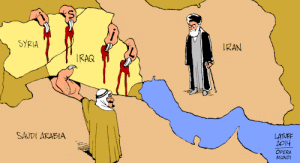By: Michal Kranz
Years ago, at the height of the Iraq War, The Spectator’s Douglas Murray asked a highly-ranked American security official what the United States’ greatest fear in the Middle East is, in regard to stability and security. The unidentified official responded: “That the region will clarify.” Could 2014 be the start of this clarification? Could this be the beginning of the end of the order that has defined the Middle East for almost a hundred years?
At the end of the First World War, the Ottoman Empire which had held the Middle East together since the Renaissance collapsed into pieces, and for the first time in centuries, a golden opportunity arose to create strong, democratic, yet ethnically and religiously balanced states in the region. However in 1920 the victors of the Great War met in San Remo, Italy to decide the future of the Middle East as they sought fit, and erected the infamous mandate system that gave rise to the modern map of the Middle East, straight lines in the sand and all.
Jump to the end of the next World War, when European powers officially withdrew from the region but unofficially maintained influence via local strongmen, sprinkle some Israel into the mix, and you’re faced with the Middle Eastern order that has existed ever since – until 2011 that is. This year coincided with several important events: The ‘official’ conclusion of the Iraq War, the assassination of Osama bin Laden, and most importantly the beginning of the Arab Spring. While the first two were largely symbolic, the Arab Spring, which began as a genuine struggle for democratic governance, soon became a three-way fight between the Sunni, the Shia, and the powers that have defined the Middle East since World War II.
More than three years after protests broke out in Tunis in late 2010, four Middle Eastern dictators have been toppled, and alliances between local authoritarians and Western powers dating back to the Cold War have fallen apart. This scenario has resulted in two phenomena: ethnic and religious tensions that had been held in check for decades were suddenly allowed to come to the fore, and the perennial Near Eastern rivals, Saudi Arabia and Iran, were left as the primary Muslim state actors in the region.
I, unlike many journalists, have not yet lost hope in the original goals of the Arab Spring, which in countries like Tunisia, Morocco, and Jordan, has led to substantial reforms and a progressive constitution. However these successes became the exceptions to the struggle, and violent sectarian wars like Syria’s were more common results.
Perhaps this was because in Tunisia, Morocco, and Jordan there were few issues to clarify. Syria on the other hand is exactly what national clarification looks like – bloody, genocidal, and multi-faceted. It was out of this maelstrom that the Islamic State of Iraq and Syria (ISIS) arose, which in a matter of weeks went from being an Al-Qaeda affiliated militia in northern Syria to an expansive regime controlling half of Syria and Iraq and threatening the existence of the Iraqi state itself.
ISIS actually originated in Iraq during the American war there, during which the United States unwittingly hastened the process of clarification by toppling Saddam Hussein’s regime and installing one that was weak and divisive at best, allowing sectarian violence between Sunnis, Shia, and Kurds to flare up once again. ISIS remained in Iraq until the Syrian Civil War broke out, which led them to take advantage of the situation and to create a stable and surprisingly well-organized base from which they could launch campaigns like the one that resulted in the capture of Mosul in June. Now arguably the most powerful actor in the Mesopotamian Valley, ISIS stands a real chance of taking Baghdad from Nouri al-Maliki and his beleaguered government – a move that would send Iraq spiraling down the path of Syria.
With Saudi-Iranian tensions at an all-time high, the collapse of an evenly split Sunni-Shia country like Iraq that has acted as a buffer between Saudi Arabia and Iran for decades could mean a hot war between the two for dominance in the Fertile Crescent. This coupled with the already terrible situation in Syria and Iraq and rising tensions in Lebanon could potentially lead to the prophesized Great Middle Eastern War, in which everyone, including Israel, would have to pick a side, and which would likely lead to the deaths of millions.
While this is the ultimate nightmare scenario for Western powers, I believe that the question that should be asked is not if this war will occur, but when. Attempts at clarification have occurred in the past, in Lebanon for instance, but have never resulted in any real change in the status quo. Unfortunately, this status quo is not sustainable, and has had to be held together by force since the Second World War. Until the start of the 21st century, the Middle East was the primary source of global oil, and it was in everyone’s interest that everything move smoothly, but now that alternate and less risk-prone sources of oil are being utilized and the West has exhausted itself by fighting endless wars in the region, interest in the stability of the Middle East has waned. The limited gains that have been wrought from the region have not been worth the sacrifices, and it is unlikely that the US or anyone else will step in to prevent regional clarification this time around.
Even if the United States, NATO, or whoever decides to throw their hat in the ring once more, it will ultimately be a futile effort. Artificial world orders can only be sustained for so long, as the same powder kegs and historic realities will keep on cropping up. Just like the Yugoslav Wars in the 1990s and African ethnic struggles after decolonization, certain processes are simply inevitable, and the Middle Eastern trend toward clarification is no exception.
The potential Great Middle Eastern War has been likened by many analysts to the Thirty Years’ War in Europe, which, as its name suggests, dragged on for three decades, cost the lives of hundreds of thousands, and devastated central Europe economically and politically. In 1648 however, the Treaty of Westphalia ended religious conflicts on the Old Continent, shifting borders and peoples, and allowing European countries to finally start acting like conventional nation-states. This same process must and will occur in the Middle East. The difference is that unlike the Thirty Years’ War, this war will include machine guns, mortars, rockets, and genocide, and will cause devastation on a scale never before seen in the region. What will rise from the wreckage is yet to be determined, but as the old maxim goes, sometimes in order to create one must first destroy.

